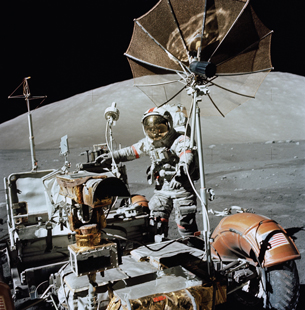Module 4—Gravitational Force
 Reflect and Connect
Reflect and Connect

Courtesy NASA
The Mars Rover transmitted this image of the landing platform after it landed on Mars.
On January 4, 2004, the Spirit rover landed on Mars. Three weeks later, on January 25, 2004, the Opportunity rover landed on the other side of the planet. See the view from the Opportunity spacecraft as it approached Mars in the short Lesson 3 Reflect and Connect video.
Both Opportunity and Spirit successfully landed on the planet and were able to drive off their platforms and explore the surface for many years.
In the planning stages of this mission, scientists had to engineer a delivery system that would be able to descend in the gravitational field surrounding Mars and ensure the rovers were not damaged when they landed. NASA would also need to design a locomotion system that would allow the rovers to move over the surface of the planet. By April 4, 2006, Spirit had lasted almost 9 times longer than planned, and the motors on Spirit's wheels had rotated more than 13 million times, exceeding the design standards by an incredible amount. At this point, one of the six wheels on the rover had failed and questions began about its ability to continue to drive successfully on five wheels while dragging its sixth wheel in the sand. As of March 2007, both rovers continue to operate on Mars.
In a couple of paragraphs, explain how NASA engineers applied Cavendish’s work and Newton’s law of universal gravitation when the following tasks were completed:
- The spacecraft had to approach Mars at a very high rate of speed while being pulled in by an increasingly strong gravitational field. Scientists needed to slow the spacecraft down considerably before it reached the atmosphere and slow the spacecraft down some more again before it reached the surface.
- The rover had to survive a direct impact when it reached the surface.
- The rover’s locomotion system had to support its weight on Mars, on a relatively unknown terrain with hills and rocks.
- The rover’s locomotion system had to operate on minimal power.
You can learn all about the rovers at the NASA website. You can find the website using a search engine.
 Discuss
Discuss

Courtesy NASA
The work of Newton and Cavendish helped scientists understand how to get to the Moon and what to expect when landing. Humans landed on the moon six times, starting with Apollo 11 in 1969 and ending with Apollo 17, which left the Moon on December 19, 1972. You can learn about the Apollo missions at the NASA website.
Humankind has not been to the Moon since 1972, but now there are plans for a permanent human presence on Earth’s closest neighbour.
This has led to questions:
- Why would scientists want to go back to the Moon?
- Why would scientists want to go to Mars?
In the discussion forum, prepare your best answer to the previous questions. Choose any two of the following six themes, which were identified by NASA as reasons for exploring the Moon and Mars. Describe what it would mean if humans and robots established a permanent settlement on the Moon:
- human civilization
- scientific knowledge
- global partnership
- economic expansion
- public engagement
- exploration preparation
Place your finished work in your Physics 20 course folder.
 Reflect on the Big Picture
Reflect on the Big Picture
Each of the Reflect on the Big Picture sections in this module will ask you to consider travel to, exploration of, or study of space. To help you consider the concepts from this lesson, complete at least one of these activities:
- Explore the role of remote-controlled space exploration. How do costs, challenges, advantages, and disadvantages affect which technologies are used to overcome the challenges of gravity and the inhospitality of space?
- Looking back on the impact on the world of Sputnik and the lunar race, where do you think space travel and exploration is headed in the next decade? What is different between the present and when Sputnik started the space race? What will drive the economic investment needed for future space travel and exploration? How is it possible you could benefit?
Store your completed reflection in your Physics 20 course folder.
 Module 4: Lesson 3 Assignment
Module 4: Lesson 3 Assignment
Remember to submit the Module 3: Lesson 4 Assignment to your teacher.